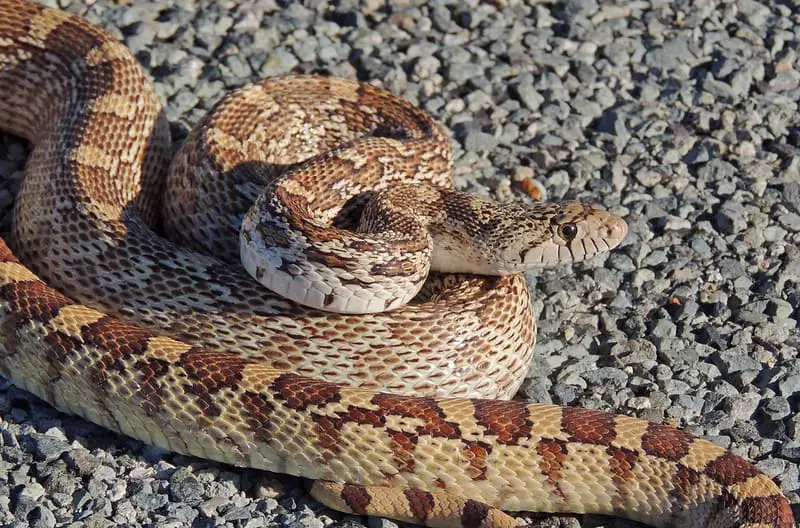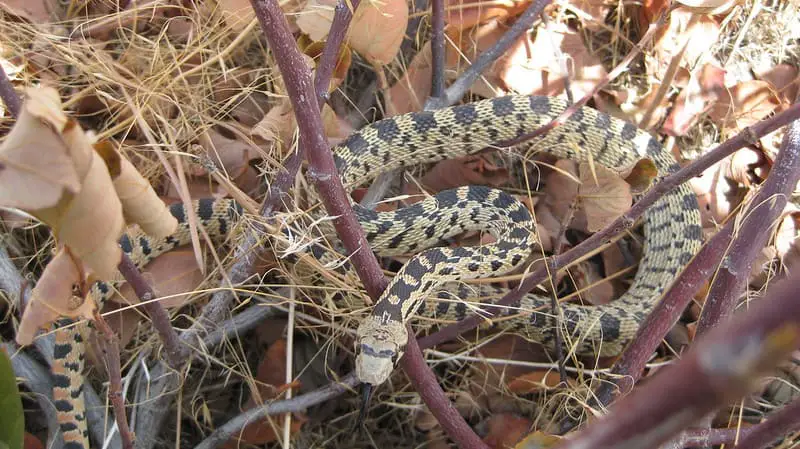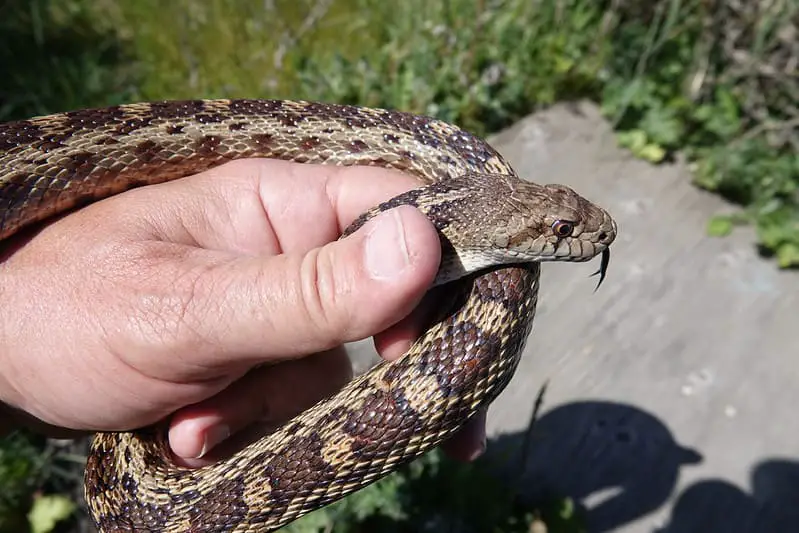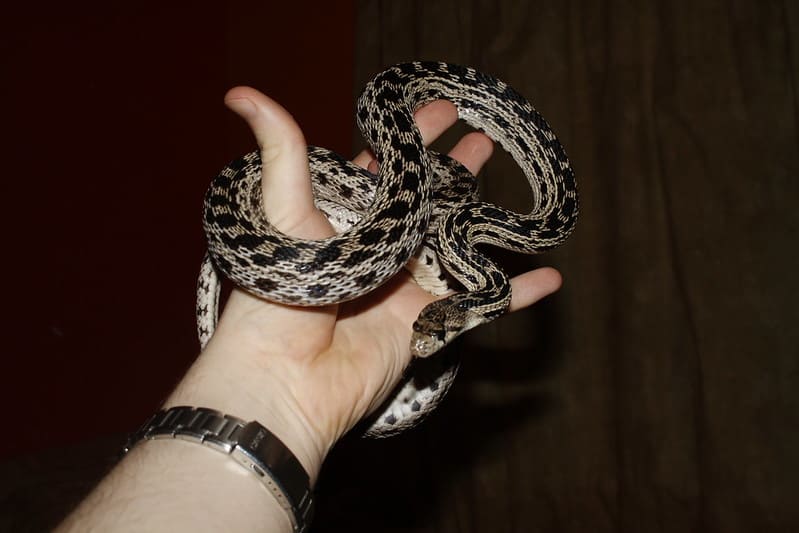Gopher snakes (Pituophis catenifer), also known as bullsnakes, are non-venomous colubrid snakes found in various regions of North America. These snakes are often misidentified as rattlesnakes due to their similar appearance and defensive behavior, which involves mimicking the rattling sound of a rattlesnake’s tail. The confusion surrounding gopher snakes, coupled with the fear of venomous snakes, has led to misconceptions about their danger to humans. In this extensive guide, we will explore the characteristics, behaviors, and potential risks associated with gopher snakes to determine whether they can be considered dangerous.

Understanding Gopher Snakes
Before delving into the question of whether gopher snakes are dangerous, it’s important to gain a comprehensive understanding of these reptiles.
Physical Characteristics
Gopher snakes are large, robust snakes that can grow to impressive lengths, often exceeding six feet. Their coloration varies significantly, depending on their geographic location, but they generally have a background color that ranges from yellow to light brown or gray, with dark blotches and a distinct pattern. This coloration allows them to blend in with their surroundings, making them effective predators.
Geographic Range
Gopher snakes have a wide distribution throughout North America. Their range includes regions from southern Canada through the United States and into Mexico. Their habitat consists of a variety of ecosystems, including grasslands, deserts, forests, and open fields.
Diet and Feeding
These snakes are constrictors, meaning they subdue their prey by squeezing and suffocating it. Gopher snakes primarily feed on small mammals, such as rodents, and they are particularly efficient at controlling rodent populations. This ecological role makes them valuable to the ecosystem, as they help keep pest populations in check.
Defensive Behavior
One of the most distinctive features of gopher snakes is their defensive behavior, which is often misunderstood as aggressive or dangerous. When threatened, gopher snakes will hiss loudly and inflate their bodies to appear larger. They may also strike, although they are non-venomous and cannot inject venom. Additionally, they mimic the rattling sound made by rattlesnakes, further contributing to the misconception that they are dangerous.
Reproduction
Gopher snakes are oviparous, which means they lay eggs. They typically lay clutches of eggs in concealed locations, such as burrows or rotting logs. After the eggs hatch, the hatchlings are left to fend for themselves without parental care.

Are Gopher Snakes Venomous?
One of the most critical factors in determining whether a snake is dangerous to humans is its venomous or non-venomous nature. Gopher snakes are unequivocally non-venomous, which means they lack the ability to inject venom into their prey or potential threats. They capture their prey through constriction, as mentioned earlier, rather than by injecting venom. Therefore, from a venom perspective, gopher snakes pose no direct danger to humans in terms of envenomation.
Misidentification with Rattlesnakes
Gopher snakes’ resemblance to rattlesnakes is one of the primary reasons for the misconception that they are dangerous. This resemblance is due to several factors, such as their similar coloration, pattern, and defensive behaviors.
Coloration and Pattern
Gopher snakes often exhibit coloration and patterns that closely mimic rattlesnakes found in their respective geographic regions. For example, the Pacific gopher snake (Pituophis catenifer catenifer) in California can closely resemble the Northern Pacific rattlesnake (Crotalus oreganus oreganus) in color and pattern. This mimicry can easily lead to misidentification.
Defensive Behavior
Gopher snakes’ defensive behavior is another factor that contributes to their misidentification. When threatened, they will coil up, hiss, strike, and mimic the rattling sound of a rattlesnake’s tail. While this behavior may be intimidating, it is a bluff intended to deter potential predators or threats.
Geographic Overlap
Gopher snakes and rattlesnakes often share the same geographic regions, further increasing the likelihood of encounters and confusion. In areas where both species are present, it is essential to be able to distinguish between them to avoid unnecessary harm to gopher snakes and ensure safety around venomous species.

Harmless to Humans
Given that gopher snakes are non-venomous and do not pose a direct threat to humans, it is accurate to say that they are harmless. While they may display intimidating defensive behaviors when confronted, these behaviors are meant to deter potential threats, not to cause harm. In fact, gopher snakes can be valuable allies to humans by helping control rodent populations, which can have economic and health-related implications.
Potential Risks and Misunderstandings
Although gopher snakes are non-venomous and not inherently dangerous to humans, there are potential risks and misunderstandings that can arise in interactions with these snakes. It is essential to address these issues to ensure safe and responsible interactions with gopher snakes.
1. Misidentification
The primary risk associated with gopher snakes is the potential for misidentification as venomous snakes, particularly rattlesnakes. In regions where rattlesnakes are prevalent, this misidentification can lead to unnecessary fear, injury to the snake, or even unlawful killing due to perceived danger.
2. Defensive Strikes
When cornered or provoked, gopher snakes may strike in self-defense. While their bites are non-venomous, they can still cause minor puncture wounds and discomfort. Avoiding unnecessary handling or provocation is crucial to reduce the risk of bites.
3. Legal Protection
Gopher snakes are protected by state and federal laws in many areas due to their ecological importance and the need for conservation. Killing or harming these snakes, even unintentionally due to misidentification, may result in legal consequences.
4. Ecosystem Role
As mentioned earlier, gopher snakes play an essential role in controlling rodent populations. Misunderstanding their importance and killing them may have negative consequences for ecosystems, agriculture, and pest control efforts.
Responsible Encounters with Gopher Snakes
When encountering gopher snakes or any other wildlife, responsible and ethical behavior is paramount. Here are some guidelines for responsible interactions with gopher snakes:
1. Educate Yourself
Educate yourself about the local snake species in your area, including both venomous and non-venomous varieties. Learn to distinguish between gopher snakes and venomous snakes based on their physical characteristics and behaviors.
2. Keep a Safe Distance
When encountering a gopher snake, maintain a safe distance and avoid any actions that may provoke or threaten the snake. Do not attempt to handle the snake unless you are experienced and confident in your identification.
3. Do Not Harm or Kill
Understand that gopher snakes are harmless and ecologically valuable. Do not harm or kill them, even if you are afraid or unsure of their identity. Killing non-venomous snakes is not only unethical but may also have legal consequences.
4. Relocate If Necessary
If a gopher snake is found in an area where it poses a potential risk to humans or where it may be at risk of harm due to human activities, consider safely relocating it to a more suitable location. Ensure the snake’s safety and well-being during the relocation process.
5. Teach and Educate
Share your knowledge about gopher snakes and snake identification with others. Educate your community about the importance of coexisting with these reptiles and the benefits they provide to the ecosystem.
6. Use Caution in Rattlesnake Country
In regions where venomous rattlesnakes are present, exercise extra caution. Always assume any snake you encounter is venomous until you can confidently identify it as non-venomous. If uncertain, maintain a safe distance and contact local wildlife authorities for assistance.
7. Local Regulations
Familiarize yourself with local and state regulations regarding the handling and protection of wildlife, including gopher snakes. These regulations may vary by region and should be adhered to when encountering these snakes.

Conclusion
Gopher snakes are not dangerous to humans, as they are non-venomous and pose no direct threat. However, the confusion and misidentification of gopher snakes as venomous rattlesnakes have led to the misconception that they are dangerous. It is crucial to educate oneself and others about these reptiles, treat them with respect, and avoid any actions that may harm them.
Responsible interactions with gopher snakes involve understanding their role in the ecosystem, appreciating their value in controlling rodent populations, and ensuring their well-being in the wild. By promoting coexistence and educating others about the benefits of gopher snakes, we can dispel the myth of their danger and contribute to their conservation and protection.
